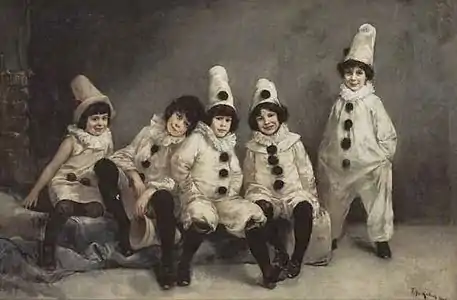Friedrich August von Kaulbach | |
|---|---|
 Kaulbach in 1907; photograph by Frank Eugene | |
| Born | 4 June 1850 |
| Died | 26 July 1920 |
| Nationality | German |
| Education | Kunstgewerbeschule |
| Known for | portraitist, historical scenes |
| Notable work | Spanish Dancer, Girl in the Woods, Girl with her dog |
Friedrich August von Kaulbach (2 June 1850 in Munich – 26 July 1920 in Ohlstadt, Germany) was a German portraitist and historical painter.
Biography
He was born to a family that included several well known artists and began his studies with his father, Friedrich Kaulbach. He then attended the Academy of Fine Arts, Nuremberg, where he studied with August von Kreling and Karl Raupp. He transferred to the Academy of Fine Arts, Munich, in 1871 and worked with Wilhelm von Diez. In 1883, he became a teacher there himself.[1]
Along with Franz von Lenbach and Franz von Stuck, he was known as one of the "Malerfürsten" (painter princes) and was one of the highest paid portrait painters in Germany. His works were commissioned by the uppermost social circles there and in America. His painting, "Children's Carnival" (the five children of mathematician Alfred Pringsheim), shows Katia Pringsheim (far left), who would later marry the writer, Thomas Mann. Several stays in Paris followed. In 1886, he was appointed Director of the Munich Academy and was ennobled.[2] He was also a member of the Prussian Academy of Art in Berlin.
In 1897, he married Frida Scotta, a famous Danish violist.[3] His daughter Hedda married the sculptor, Toni Stadler, and his daughter Mathilde, who was a singer, married the painter Max Beckmann.
His brother, Sigmund (1854–1894), was also a painter, as were his half-siblings, Anton and Antonie. His half-sister, Isidore, was a novelist.
In 1893, he built the Kaulbach-Villa in Ohlstadt, which served as a second summer residence. Since 1997, it has been a museum, showing thirty of his paintings and a number of drawings. His studio is maintained in its original state.
Selected paintings
 Study for a portrait of the singer, Geraldine Farrar
Study for a portrait of the singer, Geraldine Farrar Children's Carnival
Children's Carnival_-_Portrait_of_the_actress_Hanna_Ralph_(1885-1978).jpg.webp) Portrait of the actress, Hanna Ralph
Portrait of the actress, Hanna Ralph Portrait of his wife, Frida
Portrait of his wife, Frida The Spanish dancer, Rosario Guerrero, as Carmen
The Spanish dancer, Rosario Guerrero, as Carmen
See also
References
- ↑ "Kaulbach, Friedrich August von; Zeitraum: 1883–1891". Matrikeldatenbank. Akademie der Bildenden Künste München.
- ↑ "Artists & Publications – Dr. Moeller & Cie. Kunsthandel". moellerart.net.
- ↑ Albert Ernest Wier (1938), The Macmillan Encyclopedia of Music and Musicians, p. 1703
Further reading
- Georg Habich, "Friedrich August von Kaulbach", in: Die Kunst für alle: Malerei, Plastik, Graphik, Architektur, Vol.15, F. Bruckmann, 1900 (Die Kunst für alle: Malerei, Plastik, Graphik, Architektur (15.1899/1900), Die Kunst für alle: Malerei, Plastik, Graphik, Architektur (15.1899/1900) Online)
- Evelyn Lehmann, Elke Riemer: Die Kaulbachs. Eine Künstlerfamilie aus Arolsen, Waldeckischer Geschichtsverein, Arolsen 1978.
- Brigitte Salmen (Hrsg.): „Ich kann wirklich ganz gut malen“. Friedrich August von Kaulbach – Max Beckmann, Murnau, 2002 ISBN 978-3-932276-12-5
- Klaus Zimmermanns (1977), "Kaulbach, Friedrich August Ritter von", Neue Deutsche Biographie (in German), vol. 11, Berlin: Duncker & Humblot, pp. 354–356; (full text online)
- Klaus Zimmermann, Friedrich August von Kaulbach: 1850–1920 ; Monographie und Werkverzeichnis, Materialien zur Kunst des 19. Jahrhunderts, Vol.26, Prestel, 1980 ISBN 3-7913-0457-7
External links
- More works by Kaulbach @ ArtNet
- Literature by and about Friedrich August von Kaulbach in the German National Library catalogue
- Kaulbachs Germania Deutsches Historisches Museum, Berlin – Inv.-Nr.: 1988/82